[Emulate] Typical Modeling Patterns with TLM API
Typical Modeling Patterns with TLM API1
Modeling Techniques and Guidelines
- Leverage
tlm_fifoto connect incompatible interfacestlm_fifoprovides interfaces in blocking and non-blocking forms- Can do blocking puts into the fifo, and non-blocking gets out of it
- Leverage exiting TLM components as much as possible
tlm_fifo<T>,tlm_req_rsp_channel<REQ, RSP>,tlm_transport_channel<REQ, RSP>,
- Create generic TLM modules, channels, adapters, etc
- Generic crossbar, pipeline, cache, parallel-to-serial adaptor
- Use deterministic modeling
- Use two-phase TLM channels
- Use two-phase primitive channels in SystemC
- Employ explicit two-phase synchronization scheme
Routers
Route the traffic generated by one master to one of the slaves
- Receive a request from the master
- Attempt to find an address range which contains this address
- Return a suitable protocol error if it is not successful
- Subtract the base address of the slave from the request
- Forward the adjusted request to the slave
- Send the response back to the master
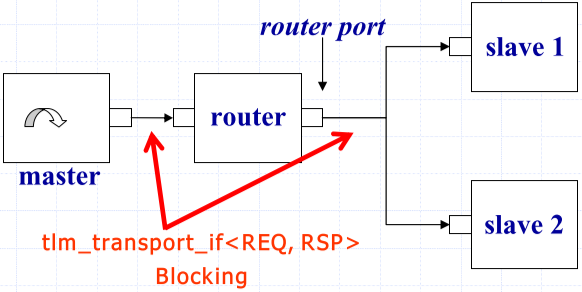
int sc_main( int argc , char **argv )
{
master m("master");
router< ADDRESS_TYPE , REQ, RSP > router("router" , "master.iport.map");
mem_slave s1("slave_1");
mem_slave s2("slave_2");
m.initiator_port( router.target_port );
router.r_port( s1.target_port );
router.r_port( s2.target_port ); sc_start( -1 );
return 0;
}
RSPconstructor must initialize the response to an error stateREQmust supportget_address()
Arbiter
- Arbitrate between two simultaneous requests with timed models
- In a pure PV model, arbitration is a meaningless concept
- Masters
- Put a request into their transport channel
- Wait for a corresponding response
- Arbiter
- Poll all the request FIFOs using
nb_get - Forward the request to the slave
- Put the response into the response FIFO in the relevant channel
- Poll all the request FIFOs using
- Multimap (in stl library)
- A one to many mapping from priority level to port
- Can be configured and reconfigured at any time
- Come with many access functions useful for arbitration
- Easy to find all ports of the same priority level for use in a prioritized round robin arbitration scheme
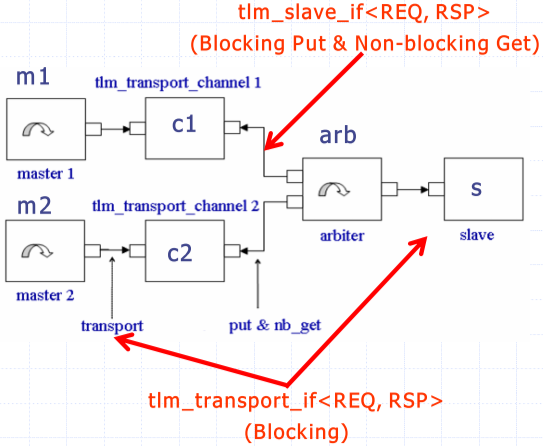
Decentralized Routing
- Centralized routing may diverge too far from the implementation
- Decentralized routing
- All of the slaves monitor all of the requests coming in using peek
- Pop the request out of the request fifo using get
- Processes the request and sends a response to the response fifo
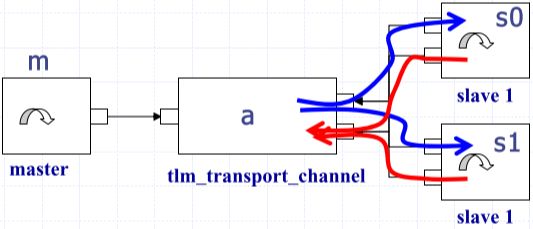
Pipeline
- Separate the data transfer into address phase and data phase
void pipelined_master::address_phase()
{
for( int i = 0; i < 20; i++ )
{
initiate_write( i , i + 50 );
initiate_read( i );
}
}
void pipelined_master::data_phase()
{
data_phase_request<ADDRESS_TYPE> data_req;
data_phase_response<DATA_TYPE> data_rsp;
while( true ) {
data_req = outstanding.get();
data_rsp = data_port->transport( data_req );
}
}
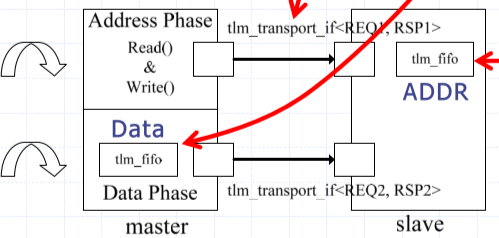
Architectural Exploration Using TLM API
Hub and Spoke
- All transactions pass through a central hub
- The hub arbitrates between the various requests
- Not efficient in terms of throughput
- Efficient in terms of area and cost
- Only 1 arbiter is needed
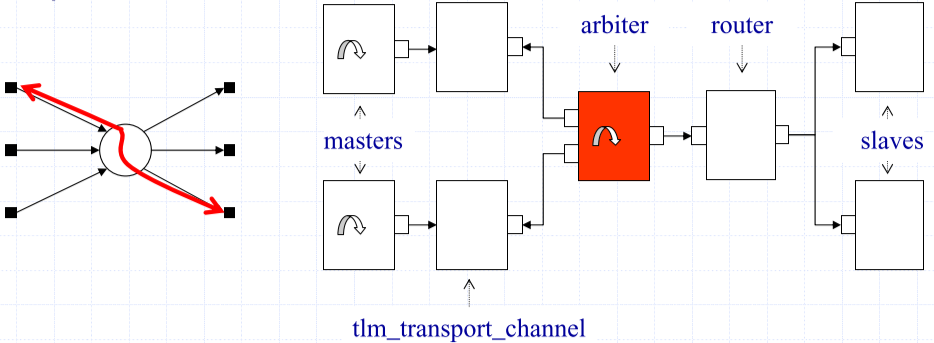
Cross Bar Switch
- Being able to make more than one connections at the same time
- No central arbitration
- Every slave has to arbitrate between all the masters
- More expensive and less predictable
- Better throughput
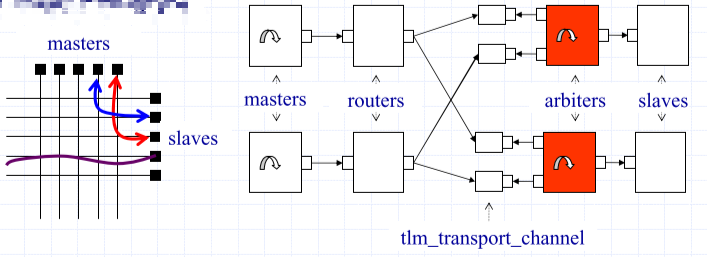
-
IOC5080(5940) System Model Design and Verification, Department of Computer Science, National Chiao-Tung University ↩